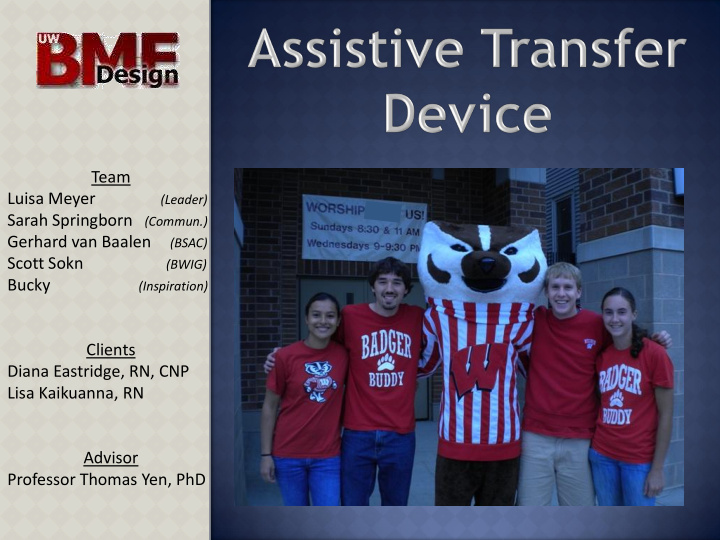



Team Luisa Meyer (Leader) Sarah Springborn (Commun.) Gerhard van Baalen (BSAC) Scott Sokn (BWIG) Bucky (Inspiration) Clients Diana Eastridge, RN, CNP Lisa Kaikuanna, RN Advisor Professor Thomas Yen, PhD
Problem Statement I. Need for Device i. Design Specifications II. Background i. Review of Previous Design III. What went wrong? i. Where can we improve? ii. Design Analyses IV. Future Work V. Design/Fabrication i. IRB ii.
Safely transfer patients from wheel chair to exam table Patients should feel secure while lifted Reduce Physical exertion of both patient and medical personnel
Manual Labor Method Assistant wraps arms around patient Holds patient while slowly rotating toward table Hoists patient onto exam table Risks http://www.corpmed.com/images/patient-transfer.jpg Large effort from assistant Uncomfortable for patient and assistant Dependent on assistant strength Hoyer Lift Mostly for Wheelchair-bound patients Have to get sleeve underneath patient http://dehanmedequip.com/images/electric%20hoyer%20lift.jpg
Able to lift 300 lbs. (Safety factor of 2x) Lift 10-15 in. Rotate Patient Portable (Device < 50 lbs. or on wheels) Easy Storage Under a bed/behind a door/ against a wall Stable
Limitations Can only help patients able to stand with assistance of nurse or walker Initial Step up is 3.5 in. Friction in joints require oiling Total Weight is 60 lbs. Issues to improve Mechanical advantage of actuator Reduce Extrusions (wheels and cylinder) – ideally fitting both underneath device General Stability during ascent and descent Binding issues of scissor-links
Reduces Step height Increases Mechanical advantage 5” 2” step
Flying Diamond Last Year F F Double Whammy Double Flying Diamond F F
Premade Electric Car Jack Hydraulic Actuator http://www.m-99.co.uk/Electric_Car_Jack/electric_car_jack.html Electric Motor - Drive Shaft
Design Feasibility Variability Cost (x2) Storage (x2) Safety Total Hydraulics 1 4 4 5 4 18 Premade Electric Jack 4 8 1 4 4 21 Drive Shaft 2 5 4 8 4 23
Perform force calculations on SolidWorks model Calculate motor torque Order Materials Fabricate Apply for IRB
Step Height Stair heights range from 6 ½” to 9 ½” [4] Elderly women range of motion of about 59.23 ± 13.77° [2] Maximum knee flexion during an 8” step is 90.8 ° [5] A study showed that 80% of the women tested (ages 75-93) were able to step up higher than 20 cm (7.87”) [1] Stance Stance width ranges from 0.05 m to 0.29 m (2” to 11.4”) [3]
Target population: nursing homes Significance: Maximum step height Stance Width Social Science IRB Approval Survey for elderly people Test different step heights Rate on comfort/difficulty
[1] Bergland A, Sylliaas H, Jarnlo GB, Wyller TB. Health, balance and walking as correlates of climbing stairs. J of Aging and Physical Activity , 2008;16:42-52. [2] Larsen AH, Sorensen H, Puggaard L, Aagaard P . “Biomechanical determinants of maximal stair climbing capacity in healthy elderly women .” Scandinavian J of Med & Science in Sports , 2009;19:678-686. [3] Mcllroy WE and Maki BE. “Preferred placement of the feet during quiet stance: development of a standardized foot placement for balance testing .” Clinical Biomechanics , 1997;12:66-70. [4] Occupational Safety and Health Administration. Standard 1910.24(e). <http://www.osha.gov/pls/oshaweb/owadisp.show_document?p_table=standards &p_id=9716>. [5] Smutnick JA, Bohannon RW. “Hip and knee flexion of lead and trail limbs during ascent of a step of different heights by normal adults .” Phys Ther , 2009;95:289- 293.
Recommend
More recommend